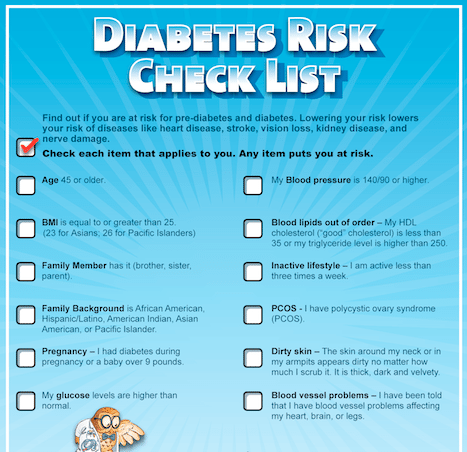What is Your Diabetes Risk?
 According to the National Diabetes Information Clearinghouse (NDIC), diabetes affects 25.8 million people in the United States. That's 8.3 percent of our population (1)! Diabetes is a serious disease that can be dangerous to your health if not managed correctly. In fact, diabetes is the leading cause of kidney failure, new cases of blindness, and non-traumatic lower-limb amputations among adults in the United States. It is also the seventh most common cause of death in the U.S. and a factor in many incidences of heart disease and stroke (1).So, how can you reduce your diabetes risk? Start by learning more about the disease...What is Diabetes?Diabetes is a metabolic disease that keeps your blood sugar high because your body either can’t process or produce insulin correctly.Insulin is a chemical in your body that turns glucose into energy.Glucose is a simple sugar that your body needs in order to carry out its daily tasks.When you test blood sugar, you’re testing the level of glucose in your blood.Types of DiabetesType one diabetes happens when the body starts destroying pancreatic cells that make insulin.Type two diabetes happens when cells in fat, muscle, or liver tissue stop processing insulin correctly.Either way, the pancreas becomes overworked as it tries to keep up with increased demand.There is no cure for type II diabetesPre-diabetes happens when your glucose levels are high, but not high enough to be full-blown diabetes. If you have pre-diabetes, you should check your blood glucose levels every year.Who Is at Risk of Developing Diabetes?Family and personal history can put you at risk, as can your lifestyle.Family history risks include…
According to the National Diabetes Information Clearinghouse (NDIC), diabetes affects 25.8 million people in the United States. That's 8.3 percent of our population (1)! Diabetes is a serious disease that can be dangerous to your health if not managed correctly. In fact, diabetes is the leading cause of kidney failure, new cases of blindness, and non-traumatic lower-limb amputations among adults in the United States. It is also the seventh most common cause of death in the U.S. and a factor in many incidences of heart disease and stroke (1).So, how can you reduce your diabetes risk? Start by learning more about the disease...What is Diabetes?Diabetes is a metabolic disease that keeps your blood sugar high because your body either can’t process or produce insulin correctly.Insulin is a chemical in your body that turns glucose into energy.Glucose is a simple sugar that your body needs in order to carry out its daily tasks.When you test blood sugar, you’re testing the level of glucose in your blood.Types of DiabetesType one diabetes happens when the body starts destroying pancreatic cells that make insulin.Type two diabetes happens when cells in fat, muscle, or liver tissue stop processing insulin correctly.Either way, the pancreas becomes overworked as it tries to keep up with increased demand.There is no cure for type II diabetesPre-diabetes happens when your glucose levels are high, but not high enough to be full-blown diabetes. If you have pre-diabetes, you should check your blood glucose levels every year.Who Is at Risk of Developing Diabetes?Family and personal history can put you at risk, as can your lifestyle.Family history risks include…
- Ethnicity
- Relatives who have type II diabetes
Personal history risks include…
- Age of 45+
- High glucose levels
- Blood pressure of 140/90+
- HDL cholesterol of 35-
- BMI of 25+
- Triglyceride level of 250+
- Polycystic ovary syndrome
- Dirty skin you can’t clean
Lifestyle risks include…
- Lack of regular exercise
- Obesity
Symptoms of DiabetesDiabetes symptoms include increased…
- Thirst
- Hunger
- Urination
- Fatigue
Other symptoms include…
- Blurred vision
- Weight loss
- Body sores
- Skin rashes
Eat Right and Decrease Your Diabetes RiskIncrease your consumption of…
- Fruits
- Vegetables
- Whole Grains
- Beans
Decrease your consumption of…
- Fats
- Sugar
- Sodium
Keep your fat consumption below 56 grams per day.Keep your sodium consumption below 2,000 mg per day.Keep a food journal to track what you eat each day.Keep Active and Decrease Your Diabetes RiskTry to be active in some way every single day.Start small, with walks or jogs.Shoot for getting at least 30 minutes of exercise 5 days per week.There Is Always Hope!If you are overweight, you only need to lose 5-7% of your overall weight in order to significantly decrease your diabetes risk.
(1) http://diabetes.niddk.nih.gov/dm/pubs/statistics/#fastFor More Information:
- American Diabetes Association - www.diabetes.org
- Juvenile Diabetes Research Foundation International - www.jdrf.org
- National Center for Chronic Disease Prevention - www.cdc.gov/diabetes/
- National Diabetes Education Program - http://ndep.nih.gov/
- National Diabetes Information Clearinghouse - http://www.diabetes.niddk.nih.gov
The information in this post comes from the NDIC and our very own Diabetes Risk 101 presentation set. Check it out today, or browse other topics in our Nutrition Education Store.


